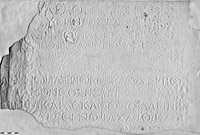 MAMA XI 110 (Akmoneia)
MAMA XI 110 (Akmoneia) 
Dedication of an altar to Zeus Alsenos
- Type of monument:
- Altar.
- Location:
- Kayılı (Akmoneia): in a lane.
- Description:
- Marble bomos broken below left, and behind. Lines 1-2 of the inscription on the upper moulding, lines 3-4 on the bevelling below, lines 5-9 on the shaft.
- Dimensions:
- Ht. 0.46+; W. 0.54+ (shaft); Th. 0.38+; letters 0.020-0.025.
- Record:
- Squeeze; line drawing; MB notebook copy; photograph (1955/94).
- Publication:
- Drew-Bear and Naour 1990: 1929-31 (SEG 40, 1192; Merkelbach and Stauber 2001: 16/03/02).
- Date:
- AD 215/6 (Year 300 of Sullan era)
ἀγαθῇ τύχῃ
[ἡ] σ̣υνβίωσις
[Ἀ]λ̣σηνῷ εἵλεως τῇ
κ̣ατοικίᾳ v. ἔτους· τ´ ·
5[Ἀ]λσηνῷ πατρίῳ μεγάλῳ Δι·ὶ· βω-
vac. μὸν ἔθηκαν vac.
[ἐ]ννεακαίδεκα φῶτες λαμπροὶ
[ vac. ] κ̣αὶ σεμνοὶ Ἀχαιοί vac.
[- - - - - - - - -] φ̣[. . . .] Λ̣υκεί̣ῳ̣ τ[. . ]
- - - - - - - - - - - - - - -
Lines 7-8: φῶτες, λαμπρ|ὲ Δί, σεμνοὶ Ἀχαιοί Drew-Bear and Naour.
Line 9: ‘Les traces de lettres préservées à la l. 9 pourraient être interprétées comme les restes du génitif poétique λύκοιο, suivi par un trait horizontal en haut de la ligne’ (Drew-Bear and Naour 1990: 1930 n.66)
With good fortune. The association, to Alsenos; may he be kindly to the village. Year 300. The 19 men, splendid and noble Achaeans, dedicated the altar to the great ancestral Zeus Alsenos... Lykeios/n...






This monument is the upper part of an altar to Zeus Alsenos, set up by a cultic association (συνβίωσις, line 2) of nineteen men (ἐννεακαίδεκα φῶτες, line 7) for the protection of their village. Lines 1-4 are in prose; lines 5-8 form two (rather careless) dactylic hexameters. The monument is dated to Year 300 of the Sullan era (=AD 215/6).
The cult of Zeus Alsenos was very widespread in central and northern Phrygia (Drew-Bear and Naour 1990: 1915-31; Drew-Bear, Thomas and Yıldızturan 1999: 13-15, 371). The phrase εἵλεως τῇ κατοικίᾳ in lines 2-3 signifies ‘may he be kindly to the village’, with an implicit optative of wish (γένοιτο, εἴη): compare e.g. TAM V 1, 523 (Maionia: dedication to Hekate), σῷζέ με τόνδ᾿ ἀναθέντα καὶ εἵλεως ἴσθι βροτοῖσιν; TAM V 2, 881 (Thyateira), εἴη οὖν ὁ Ἀπόλλων ἵλεως διὰ παντὸς Ἀργείωι; TAM V 2, 1148 (Thyateira), μήτε οἱ θεοὶ ἵλεως αὐτῷ γένοι[ν]το; MAMA VIII 297 (Ikonion), [εὔχομαι θ]εοὺς σωτῆρας... ἵλεως καὶ ε̣[ὔνους εἶναι τῆ]ι̣ κολωνείαι Εἰκονίωι. The letters ΕΙΛΕΩΣ probably represent an indeclinable adjective ἵλεως (Naour 1981: 21); note however that Petzl in his commentary on TAM V 3, 1539.46-7 (Philadelpheia) takes the word to be an adverb, and accents accordingly (ἱλέως).
The συνβίωσις consisted of 19 men; Drew-Bear and Naour compare TAM V 1, 537 (Maionia), a συνβίωσις of 18 men, and TAM V 1, 187 (near Saittai), a συνβίωσις of 17 men (including the honorand). The members of the association describe themselves as ‘splendid and noble Achaeans’ (the reading λαμπροὶ at the end of line 7 is certain). The inhabitants of this katoikia on the territory of Akmoneia, like many communities in central and southern Phrygia (including the neighbouring cities of Eumeneia, Temenouthyrai, Sebaste), claimed to be colonists from Argos (Weiss 2000b). In the second century AD, the inhabitants of Eumeneia called themselves the Εὐμενεῖς Ἀχαιοί, and a cult of θεὸς Ἀχαιός is attested in Phrygia (Robert 1987: 392-4). The dative Λυκείῳ in line 9 may also suggest a connection with Argos; Apollo Lykeios was the principal deity of Argos (Pausanias 2.19.3), and the claim of the citizens of Tarsos in Kilikia to Argive origins was based on their cult of Apollo Lykeios, said to have been brought from Argos to Tarsos by the hero Perseus (Robert 1987: 54-69).